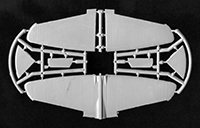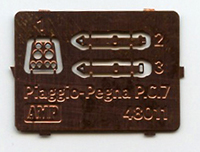
AMP 1/48 Piaggio-Pegna P.c.7 'Schneider Trophy Series' Kit First Look
By David L. Veres
| Date of Review | September 2019 | Manufacturer | AMP |
|---|---|---|---|
| Subject | Piaggio-Pegna P.c.7 'Schneider Trophy Series' | Scale | 1/48 |
| Kit Number | 48011 | Primary Media | Styrene, Photo-Etch |
| Pros | Crisp moldings, delicate details | Cons | Nothing major |
| Skill Level | Experienced | MSRP (USD) | TBA |
First Look
 |
 |
 |
 |
 |
 |
Some consider the revolutionary Piaggio-Pegna P.c.7 the sleekest, most futuristic aircraft of the 1920s.
An Italian entry in 1929’s Schneider Cup, the innovative water-borne design swapped bulky, drag-inducing floats for hydrofoil gear.
Theory seemed plausible. A ventral empennage prop pushed the racer forward until it rose from water on two hydrofoils. The pilot then engaged the main propeller – shooting P.c.7 skyward.
But the radical concept failed to fly – ever. And the Fascist government instead backed Macchi’s more conventional concepts.
File this one under “I thought I’d never see an injection-molded Piaggio-Pegna P.c.7”. But as part of its “Schneider Trophy Series”, AMP/Micro-Mir astonishingly offers Golden Age Racing fans the chance to add a 1:48-scale example to their collections.
Main components comprise 66 gray and one clear items across five trees. Interior subassemblies – engine and cockpit – alone account for 32 of those. And a tiny photoetch fret, equally miniscule masks, and a diminutive decal sheet supplement the virtually flash-free plastic parts.
Eight-page, Ukrainian-English instructions include a capsule history, paints list, 16-step assembly sequence, and one-page color guide for two minor variations of the same scheme.
AMP/Micro-Mir’s Facebook page reports a pending Macchi M.67 in its 1:48 “Schneider Trophy Series”. I can’t wait for that – or an M.72!
My sincere thanks to Micro-Mir for this review sample!







